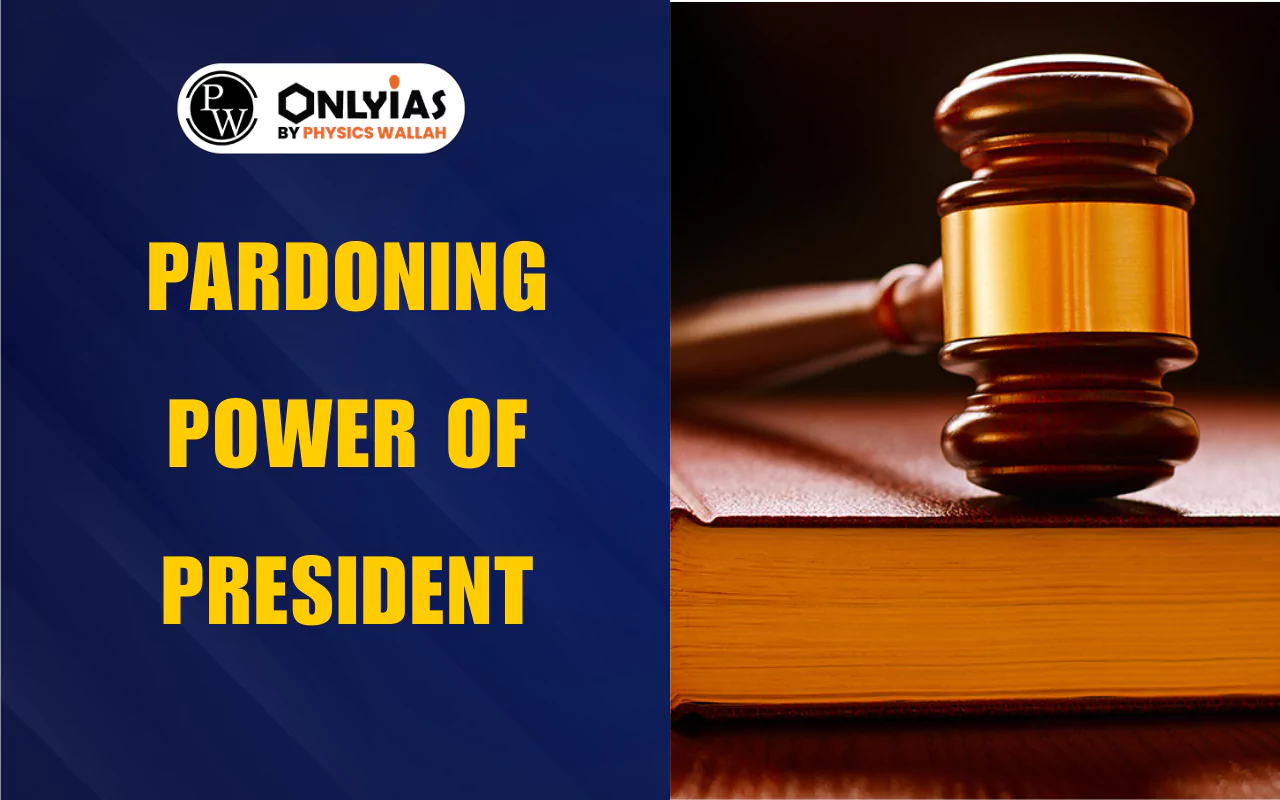Pardoning Power of President allows the President to grant clemency, including pardon, commutation, remission, respite, or reprieve under Article 72. It helps correct judicial errors, reduce harsh punishments, and show mercy. Pardoning Power of President is exercised with government advice and follows strict constitutional procedures.

Pardoning Power of President is an important constitutional provision and a power given to the President. This power is granted to the President to balance justice with mercy and ensure fairness in exceptional cases.
The President can forgive or reduce punishments, but they must follow the rules that are set by the Constitution and listen to government advice. This power helps correct mistakes, reduce very harsh punishments, and show mercy when needed.
Pardoning is a special power that can reduce or completely remove a punishment given to someone who broke the law. It is meant to show fairness, kindness, and care for people. This power is not like a judge’s decision; it comes from the government.
Its main goal is to fix cases where the punishment might be too harsh or there was a mistake in court. In India, both the President and the Governors have this power under Articles 72 and 161 of the Constitution.
The pardoning power of President is classified into five forms. These categories ensure that the President can apply leniency flexibly, considering the convict’s situation and the nature of the crime. Here we have covered each of these types in complete detail, along with a brief descriptive table.
A pardon is one of the major leniencies that is provided to the accused. When the President gives a pardon, the person is fully forgiven for the crime. They don’t have to face any punishment like jail or fines. It’s like the crime never happened, and all their legal rights are back.
| Pardon | |
| Aspect | Details |
| Scope | Death sentence, imprisonment, fines, or any offence under Union law |
| Effect | Completely removes conviction and penalties; restores full legal rights |
| Purpose | To absolve the convict entirely and correct any miscarriage of justice |
| Example | A convict sentenced to life imprisonment is released and freed from all legal consequences |
Commutation involves reducing the severity of the punishment without nullifying the conviction itself. It is used to convert a harsher punishment into a lighter one.
| Commutation | |
| Aspect | Details |
| Scope | Death sentence, imprisonment, or other severe punishments |
| Effect | Reduces severity of punishment without nullifying the conviction |
| Purpose | To mitigate excessively harsh punishment |
| Example | A death sentence changed to life imprisonment |
Remission means the President reduce the time a person has to spend in jail, but the type of punishment stays the same. It’s usually given for good behaviour, health reasons, or other kinds of reasons.
| Remission | |
| Aspect | Details |
| Scope | Imprisonment or fines |
| Effect | Reduces the duration of the sentence without altering the nature of punishment |
| Purpose | To reward good behavior, humanitarian reasons, or other special circumstances |
| Example | A 10-year jail term reduced to 8 years for good conduct |
Temporarily or permanently reduces the severity of a sentence due to special circumstances, like illness or pregnancy.
| Respite | |
| Aspect | Details |
| Scope | Special cases like illness, pregnancy, or age-related issues |
| Effect | Temporarily reduces or postpones the punishment |
| Purpose | To prevent undue suffering due to exceptional circumstances |
| Example | Imprisonment of a pregnant woman delayed until after childbirth |
Reprieve is the temporary postponement or suspension of a convict’s punishment by the President. Under this additional time for legal review, filing appeals or submitting mercy petitions is given. Thereby, to ensure fairness and allow proper consideration of leniency requests.
| Respite | |
| Aspect | Details |
| Scope | Special cases like illness, pregnancy, or age-related issues |
| Effect | Temporarily reduces or postpones the punishment |
| Purpose | To prevent undue suffering due to exceptional circumstances |
| Example | Imprisonment of a pregnant woman delayed until after childbirth |
The Pardoning Power of President is granted under Article 72 of the Indian Constitution. It allows the President to grant pardons, reprieves, respites, remissions of punishment, or to suspend, remit, or commute sentences. This power applies in three specific situations:
Powers And Functions Of The President Of India
The President’s power to pardon follows important rules from the Constitution and laws. These rules make sure forgiveness is given carefully, balancing fairness with kindness.
| Principles Governing Pardoning Power | |
| Principle | Explanation |
| Presidential Action | The President cannot act independently and must follow the advice of the Council of Ministers. |
| Hearing Rights | Mercy petitioners do not have a right to oral hearings; the President may review evidence and reach a conclusion different from the courts. |
| Purpose of Power | The power can be used to correct judicial errors or excessively harsh sentences. |
| Judicial Review | Courts can review the President’s decision only in cases of arbitrariness, irrationality, bad faith, or discrimination. |
| Multiple Petitions | Filing multiple petitions does not automatically entitle the convict to reconsideration. |
| Reasoning Requirement | The President is not required to give reasons for the decision, but must act in accordance with constitutional procedures. |
Powers And Functions Of Governor In India
The Procedure for Exercising Pardoning Power is highly structured. It is through this process that care, integrity, and justice are maintained. The procedure for granting leniency under Article 72 is as follows:
Both the President and Governors have clemency powers, but their scope differs. The pardoning power of President and Governor is therefore complementary. With the President handling national-level cases and Governors addressing state-level cases.
| Pardoning Power of President vs Governor | ||
| Aspect | President | Governor |
| Legal Basis | Article 72 | Article 161 |
| Scope | Union offences, court-martial cases, death penalties | State offences |
| Advice | Central Government | State Government |
| Death Sentence | Can pardon in death penalty cases | Can only recommend in certain cases |
| Judicial Review | Limited | Limited |
Ready to boost your UPSC 2026 preparation? Join PW’s UPSC online courses today!
It is the authority of the President to grant clemency, including pardon, commutation, remission, respite, or reprieve under Article 72.
The President has five types: pardon, commutation, remission, respite, and reprieve.
Yes, judicial review is limited to cases of arbitrariness, bad faith, or discrimination.
The President handles Union offences and death penalties, while the Governor addresses state offences.
Yes, the President can grant clemency or commute death sentences under Article 72.
<div class="new-fform">
</div>
